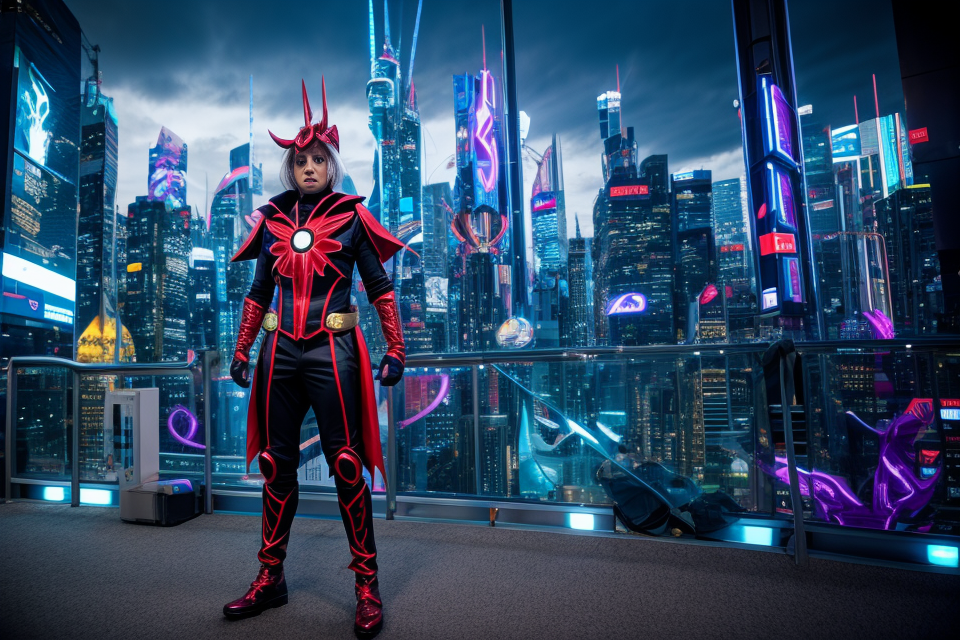Cosplay, short for “costume play,” is a popular hobby among fans of comics, anime, video games, and other forms of pop culture. It involves dressing up as your favorite characters, either by creating your own costumes or purchasing them from cosplay shops. But, the question remains, what are the limits of cosplay? Can you dress up as anything, or are there certain guidelines that must be followed? In this article, we’ll explore the boundaries of cosplay and discuss what you can and can’t dress up as for your next cosplay event. Get ready to learn about the dos and don’ts of cosplay, and let’s dive into the exciting world of costume play!
What is Cosplay?
Definition and Origins
Cosplay, short for “costume play,” is a popular hobby where individuals dress up as their favorite characters from comic books, anime, video games, movies, and television shows. The practice has its roots in Japan, where it was first introduced in the 1980s, and has since become a global phenomenon. Cosplayers often attend conventions, events, and gatherings where they showcase their costumes and interact with other fans.
Cosplay has evolved into a complex art form, with cosplayers investing significant time, effort, and resources into creating intricate costumes and props. Some cosplayers focus on replicating the costumes as accurately as possible, while others take a more creative approach by modifying or customizing the original designs. Cosplay has also become a platform for self-expression, allowing individuals to explore different identities and express their creativity.
However, with the growing popularity of cosplay, there has been increasing debate about the limits of what one can and cannot dress up as. Some argue that certain costumes are inappropriate or offensive, while others believe that cosplayers should be allowed to express themselves freely without restriction. As a result, the cosplay community is grappling with questions about boundaries, appropriateness, and representation.
Popularity and Fandom
Cosplay, short for “costume play,” is a popular form of fan expression where individuals dress up as their favorite characters from movies, TV shows, video games, and other forms of media. It has become a beloved part of fan culture, with many fans attending conventions and events specifically to show off their cosplay creations.
One of the main reasons for the popularity of cosplay is the opportunity it provides for fans to immerse themselves in the worlds and characters they love. By dressing up as their favorite characters, cosplayers can feel like they are a part of the story and can connect with other fans who share their interests.
However, while cosplay is generally accepted as a fun and harmless hobby, there are limits to what is considered appropriate to dress up as. Some costumes may be seen as offensive or inappropriate, particularly those that could be considered racist, sexist, or otherwise harmful. It is important for cosplayers to be mindful of these limits and to ensure that their costumes are respectful and inclusive.
Despite these limitations, the popularity of cosplay continues to grow, with more and more fans embracing this unique form of fan expression. Whether attending conventions, participating in online communities, or simply showing off their cosplay creations on social media, cosplayers are an integral part of the fan culture landscape.
Different Types of Cosplay
Cosplay, short for “costume play,” is a hobby where participants dress up as characters from movies, TV shows, video games, and other forms of popular culture. The activity has grown in popularity over the years, with cosplayers attending conventions and events around the world to show off their creative costumes and meet like-minded fans.
There are several different types of cosplay, each with its own unique style and approach. Some of the most popular types of cosplay include:
- Character cosplay: This type of cosplay involves dressing up as a specific character from a movie, TV show, or video game. Cosplayers often strive to replicate the character’s appearance and mannerisms as closely as possible, using detailed costumes, wigs, and makeup to create a convincing transformation.
- Crossplay: Crossplay involves cosplaying as a character of a different gender than the cosplayer. For example, a male cosplayer might dress up as a female character, or vice versa. This type of cosplay can be particularly challenging, as cosplayers must not only create an accurate costume but also embody the character’s personality and movements.
- Group cosplay: Group cosplay involves a group of cosplayers coming together to portray a scene or moment from a movie, TV show, or video game. This type of cosplay often requires a lot of coordination and communication, as well as detailed costumes and props to bring the scene to life.
- Sports cosplay: Sports cosplay involves dressing up as a specific sports team or character, such as a superhero or a mascot. This type of cosplay is often popular at sporting events and can be a fun way to show team spirit while also expressing a love for pop culture.
- Egalitarian cosplay: Egalitarian cosplay, also known as “casual cosplay,” involves dressing up as a character or creature from popular culture in a more relaxed, casual way. This type of cosplay is often less formal and less detailed than other types of cosplay, and can be a fun way to show off a favorite character without the need for a full costume and makeup.
Overall, cosplay is a highly creative and diverse hobby that allows participants to express their love for pop culture in a fun and imaginative way. Whether you prefer character cosplay, group cosplay, or any of the other types of cosplay, there is something for everyone in this exciting and evolving hobby.
Dressing Up for Cosplay: What You Can Wear
Character-Specific Costumes
Cosplayers often enjoy dressing up as their favorite characters from comic books, video games, movies, and television shows. However, while many costumes are acceptable, some can be controversial or even inappropriate. This section will explore the dos and don’ts of character-specific costumes in cosplay.
Acceptable Character-Specific Costumes
- Characters from pop culture: Popular characters from movies, TV shows, comic books, and video games are acceptable choices for cosplay. For example, you can dress up as Harry Potter, Superman, Wonder Woman, or Master Chief from Halo.
- Historical figures: Historical figures can also be cosplayed, as long as the costume is respectful and accurate. For instance, you can dress up as Cleopatra, Napoleon, or Abraham Lincoln.
- Original characters: You can also create your own original character and cosplay as that. This is a great way to showcase your creativity and imagination.
Unacceptable Character-Specific Costumes
- Racist or offensive characters: Cosplayers should avoid dressing up as characters that are racist, offensive, or insensitive. This includes characters with blackface, yellowface, or other forms of ethnic stereotyping.
- Sexualized characters: Cosplayers should also avoid dressing up as characters that are overly sexualized or inappropriate. This includes characters with revealing clothing or suggestive poses.
- Characters from controversial media: Cosplayers should be cautious when choosing characters from controversial media, such as characters from movies or video games that have been criticized for their portrayal of violence or other sensitive topics.
It’s important to remember that cosplay is a form of expression, but it’s also a form of representation. Cosplayers should always consider the impact of their costume choices on others and strive to create a welcoming and inclusive community.
Reusing Clothing and Accessories
Cosplayers often find creative ways to incorporate existing clothing and accessories into their costumes. Reusing clothing and accessories can be a cost-effective and environmentally friendly way to cosplay, as it reduces waste and the need for new materials. However, there are some important considerations to keep in mind when reusing clothing and accessories for cosplay.
One important consideration is ensuring that the clothing and accessories are appropriate for the character being cosplayed. For example, if you are cosplaying a medieval warrior, it may not be appropriate to wear modern clothing or accessories that would not fit the character’s time period or culture. It is important to do research and be respectful of the source material when choosing clothing and accessories for cosplay.
Another consideration is ensuring that the clothing and accessories are in good condition and fit properly. Wearing ill-fitting or damaged clothing or accessories can detract from the overall appearance of the cosplay and may even be unsafe. It is important to take the time to properly alter and maintain the clothing and accessories to ensure that they fit and look their best.
In addition, cosplayers should be mindful of any copyright or trademark restrictions when using existing clothing and accessories for cosplay. It is important to avoid using any trademarked or copyrighted materials without permission, as this can lead to legal issues. Cosplayers should also be respectful of the original creators of the clothing and accessories and give credit where credit is due.
Overall, reusing clothing and accessories can be a great way to cosplay on a budget and reduce waste. However, it is important to consider the appropriateness of the clothing and accessories, their condition, and any legal restrictions when using them for cosplay.
DIY and Custom Costumes
Cosplay is all about creativity and self-expression, and DIY and custom costumes are a great way to showcase your skills and bring your imagination to life. Here are some guidelines to keep in mind when creating your own costumes:
- Research: Take the time to research the character or theme you want to cosplay. Look at official artwork, concept sketches, and references to get an idea of what the character’s outfit looks like and how it’s designed.
- Sourcing materials: Consider the materials you’ll need for your costume. Will you be making everything from scratch, or will you be using existing pieces? Make sure you have the right materials for the job, and consider how much time and effort each piece will take to make.
- Skill level: Be realistic about your skill level and experience with sewing, sculpting, or other crafts. If you’re new to cosplay, start with a simple costume and work your way up to more complex designs.
- Copyright and trademark laws: When creating a costume based on a copyrighted or trademarked character, make sure you’re not infringing on anyone’s intellectual property. You can create a costume based on a character, but you can’t use logos, names, or other branding elements that belong to someone else.
- Safety: Make sure your costume is safe to wear. Use flame-resistant materials for any costumes that may come into contact with fire, and make sure your costume doesn’t obstruct your vision or impede your movement.
Creating your own costume can be a fun and rewarding experience, but it’s important to remember that cosplay is about having fun and expressing yourself, not about winning awards or impressing others. So, enjoy the process and have fun creating your own unique cosplay costumes!
Dressing Up for Cosplay: What You Can’t Wear
Copyrighted Material
Cosplay, short for “costume play,” is a popular hobby where individuals dress up as their favorite characters from movies, TV shows, video games, and other forms of media. While the freedom to express oneself through cosplay is a key aspect of the hobby, there are certain limits to what one can and cannot wear when participating in cosplay.
One of the primary limitations is the use of copyrighted material. Copyright laws protect intellectual property, including characters, logos, and other creative works. This means that individuals cannot legally cosplay as copyrighted characters without permission from the copyright holder.
In some cases, even cosplaying as a character from a public domain work can be problematic. For example, if a cosplayer chooses to dress up as a well-known historical figure, they may be accused of cultural appropriation, especially if they are not a member of the culture or ethnicity that the figure represents.
It is important to note that the laws surrounding cosplay and copyrighted material can be complex and vary depending on the country. Some countries have specific laws that protect cosplayers from legal action, while others do not.
To avoid any legal issues, cosplayers should take care to ensure that their costumes do not infringe on any copyrighted material. This means that they should avoid using trademarked logos or designs, and should refrain from making direct copies of copyrighted characters.
Additionally, cosplayers should be mindful of the context in which they are cosplaying. For example, it may be more appropriate to cosplay as a character from a video game at a gaming convention, rather than at a formal event.
Overall, while cosplay provides a platform for individuals to express their creativity and fandom, it is important to respect the limits of what one can and cannot wear when participating in the hobby. By understanding the laws surrounding copyrighted material and being mindful of context, cosplayers can ensure that their costumes are both respectful and enjoyable for all involved.
Inappropriate or Offensive Costumes
Cosplay, short for “costume play,” is a popular hobby where participants dress up as their favorite characters from comics, anime, video games, and other forms of pop culture. While cosplay is all about creativity and self-expression, there are certain limits to what one can and cannot wear when participating in this activity.
One of the most important aspects of cosplay is respect for others, and this includes avoiding costumes that may be inappropriate or offensive. Here are some guidelines to keep in mind when choosing a cosplay costume:
- Avoid costumes that are overly revealing or sexualized. While cosplay is a form of self-expression, it is important to remember that one’s body is not a tool for exploitation. Costumes that are too revealing or sexually suggestive can be offensive and make others feel uncomfortable.
- Be mindful of cultural sensitivity. Cosplay should be a fun and inclusive activity, and it is important to be respectful of other cultures. Avoid costumes that may be seen as racist, insensitive, or offensive to certain groups of people.
- Be aware of age appropriateness. While cosplay is enjoyed by people of all ages, it is important to remember that children may be present at cosplay events. Avoid costumes that may be too violent, gory, or suggestive for younger audiences.
- Avoid political or religious controversy. While cosplay is a fun and creative activity, it is important to avoid costumes that may be seen as political or religious statements. These topics can be divisive and may cause tension or conflict at cosplay events.
In summary, while cosplay is all about creativity and self-expression, it is important to be mindful of others and avoid costumes that may be inappropriate, offensive, or controversial. By following these guidelines, cosplay can be a fun and inclusive activity for everyone.
Health and Safety Concerns
While cosplaying can be a fun and creative way to express oneself, there are certain limitations to what one can wear during cosplay. These limitations are often related to health and safety concerns.
It is important to remember that certain costumes or accessories can be dangerous if not made properly or if they are too restrictive. For example, wearing a costume that is too tight or made of uncomfortable materials can cause skin irritation or even lead to heat stroke. Additionally, wearing heavy accessories or props can cause neck and back pain, leading to discomfort and potentially even injury.
Furthermore, some costumes may be deemed inappropriate or offensive, particularly those that include violent or sexual content. This can be especially true for children, who may be more vulnerable to the negative effects of such costumes. It is important to consider the potential impact of one’s cosplay on others and to refrain from wearing anything that may be deemed offensive or inappropriate.
It is also important to consider the context in which one will be cosplaying. For example, if one is attending a convention or event where children will be present, it may be wise to avoid wearing costumes that include mature or explicit content. Additionally, if one is attending a public event, it is important to consider the dress code and ensure that one’s cosplay does not violate any rules or regulations.
In summary, while cosplaying can be a fun and creative way to express oneself, it is important to consider health and safety concerns, as well as the potential impact of one’s cosplay on others. By being mindful of these limitations, one can ensure a safe and enjoyable cosplay experience for all involved.
Cosplay Etiquette: Tips for Dressing Up Responsibly
Researching Characters and Costumes
Researching characters and costumes is an essential part of cosplay etiquette. It is crucial to understand the nature of the character you wish to portray and ensure that your costume does not offend or misrepresent the source material. Here are some tips for researching characters and costumes:
- Understand the Source Material: Before you decide to cosplay a character, it is essential to understand the source material. This includes reading the comics, watching the movies or TV shows, and playing the video games that the character appears in. Understanding the character’s background, personality, and motivations will help you create an accurate and respectful cosplay.
- Consider Cultural Sensitivity: It is essential to be culturally sensitive when choosing a character to cosplay. Some characters may be associated with specific cultures or religions, and it is important to be respectful of these associations. If you are unsure about the cultural significance of a character, do some research to ensure that you are not offending anyone.
- Avoid Stereotypes: It is important to avoid stereotypes when choosing a character to cosplay. Characters that rely on stereotypes can be offensive and disrespectful to certain groups of people. Be mindful of the characters you choose and ensure that they do not perpetuate harmful stereotypes.
- Pay Attention to Age Appropriateness: It is important to consider the age appropriateness of the character you wish to cosplay. Some characters may be inappropriate for children or may contain mature themes that may not be suitable for all audiences. Be mindful of the age appropriateness of the character and ensure that your cosplay does not offend or disturb others.
- Seek Inspiration from Multiple Sources: Seek inspiration from multiple sources when creating your cosplay. This can include official artwork, fan art, and cosplay photos from previous events. However, be mindful of copyright laws and ensure that you are not copying someone else’s work without permission.
By following these tips, you can ensure that your cosplay is respectful and accurate, and that you are not offending or misrepresenting the source material.
Being Mindful of Sensitive Topics
Cosplay is a form of self-expression that allows individuals to showcase their creativity and passion for pop culture. However, it is important to be mindful of sensitive topics when choosing a costume. Here are some guidelines to keep in mind:
- Avoid dressing up as characters or using props that could be seen as offensive or insensitive. This includes costumes that are overtly sexualized or that depict controversial figures.
- Be aware of cultural appropriation. It is important to respect other cultures and refrain from dressing up in a way that could be seen as disrespectful or insensitive.
- Consider the audience and the event. Some costumes may be more appropriate for certain audiences or events. For example, a costume that is inappropriate for children may be suitable for an adult-only event.
- Remember that cosplay is a form of expression, not a disguise. It is important to act responsibly and consider the impact of your costume on others.
By being mindful of sensitive topics, cosplayers can help create a positive and inclusive community that celebrates creativity and self-expression while respecting the feelings and opinions of others.
Respecting Other Cosplayers and Attendees
As a cosplayer, it is important to be mindful of the impact your costume may have on others. Here are some tips for respecting other cosplayers and attendees at conventions:
- Be Mindful of Revealing Costumes: While cosplaying is all about expressing yourself, it is important to remember that some costumes may be revealing or inappropriate for certain audiences. It is always best to err on the side of caution and make sure that your costume is not too revealing.
- Respect Copyright and Trademark Laws: When choosing a costume, it is important to be aware of copyright and trademark laws. Make sure that you are not copying a costume from a specific movie or show without permission. It is also important to avoid using any logos or brand names that you do not have permission to use.
- Avoid Racist or Offensive Costumes: While cosplaying is a form of self-expression, it is important to be mindful of the impact that your costume may have on others. Avoid dressing up as racist or offensive characters, as this can be hurtful and disrespectful to others.
- Be Mindful of Personal Space: It is important to respect other cosplayers’ personal space and privacy. Avoid taking photos or videos of other cosplayers without their consent, and be mindful of your surroundings when posing for photos.
- Be Respectful of Different Body Types: When choosing a costume, it is important to be mindful of different body types. Avoid choosing costumes that may be too revealing or inappropriate for certain body types. It is important to be respectful of all cosplayers, regardless of their size or shape.
By following these tips, you can help create a positive and respectful environment for all cosplayers and attendees at conventions.
Communicating with Event Organizers
Effective communication with event organizers is essential to ensure that your cosplay costume adheres to the rules and regulations of the event. Here are some tips for communicating with event organizers:
- Be Clear and Concise: When communicating with event organizers, it is important to be clear and concise about your costume. Explain the design and materials used in your costume, and provide pictures if possible. This will help the organizers understand your costume and make an informed decision about whether it is appropriate for the event.
- Ask Questions: If you are unsure about whether your costume is appropriate for the event, ask the organizers. They will be able to provide guidance on what is and isn’t allowed, and can help you make any necessary changes to your costume.
- Be Respectful: When communicating with event organizers, it is important to be respectful and professional. Remember that they are volunteers who are working hard to make the event a success. Be polite and courteous, and avoid being confrontational or argumentative.
- Be Flexible: Event organizers may have specific rules and regulations that you need to follow, and it is important to be flexible and accommodating. If they ask you to make changes to your costume, try to be understanding and cooperative. Remember that their goal is to ensure that everyone has a safe and enjoyable experience at the event.
- Be Prepared: Before communicating with event organizers, make sure you have all the necessary information about the event. Know the theme, the dress code, and any other guidelines that may apply to your costume. This will help you avoid any misunderstandings or miscommunications with the organizers.
By following these tips, you can ensure that you are communicating effectively with event organizers and that your cosplay costume is appropriate for the event.
Legal Considerations for Cosplay Costumes
Copyright Law and Cosplay
Cosplayers must be aware of copyright laws when creating their costumes. Copyright law protects original works of authorship, including literary, artistic, and musical works. This means that cosplayers cannot legally make or sell costumes based on copyrighted characters or designs without permission from the copyright holder.
It is important to note that copyright law varies by country, and the specific laws and regulations may differ. For example, in the United States, copyright protection lasts for the life of the author plus 70 years, while in Japan, copyright protection lasts for 50 years from the date of publication.
Additionally, cosplayers should be aware of the fair use doctrine, which allows for limited use of copyrighted material without permission for purposes such as criticism, commentary, news reporting, teaching, scholarship, or research. However, the use of copyrighted material for cosplay purposes may not always be considered fair use.
It is also important to note that trademark law may apply to cosplay costumes as well. Trademark law protects words, names, symbols, and other distinctive marks used to identify products or services. This means that cosplayers may not legally use trademarked logos or designs on their costumes without permission from the trademark holder.
In summary, cosplayers must be aware of copyright and trademark laws when creating their costumes and should seek legal advice if they have any questions or concerns about the legality of their costume designs.
Trademark Law and Cosplay
Trademark law plays a significant role in regulating the use of intellectual property in cosplay. Trademarks are distinctive signs, words, or symbols used to identify a product or service and distinguish it from those of others. They are legally protected under the Lanham Act in the United States and similar laws in other countries.
In the context of cosplay, trademark law may come into play when a cosplayer’s costume design or accessories closely resemble a registered trademark. The likelihood of confusion is a key factor in determining whether the use of a trademark in cosplay is permissible.
Cosplayers should be cautious about using trademarked logos, emblems, or designs that are likely to confuse the public about the source or sponsorship of their costumes. Using such elements may constitute trademark infringement, subjecting cosplayers to legal action from the trademark owner.
It is essential for cosplayers to respect trademark rights and refrain from using protected elements in their costumes. However, parody or transformative use may be considered as fair use and can provide some protection for cosplayers.
To minimize legal risks, cosplayers should:
- Conduct thorough research to identify potentially protected trademarks and avoid using them in their costumes.
- Avoid using registered trademarks in the title or description of their cosplay content, as this may also create legal vulnerabilities.
- Be aware of the potential consequences of trademark infringement and seek legal advice if they are unsure about the legality of a particular costume design.
In summary, cosplayers must navigate the complexities of trademark law and ensure that their costume designs do not infringe upon the rights of trademark owners. Respecting intellectual property rights is crucial for maintaining a positive and legally compliant cosplay experience.
Public Performance and Cosplay
While cosplay is generally considered a harmless and creative hobby, there are legal considerations that must be taken into account, particularly when it comes to public performances. When cosplayers choose to participate in public events, such as conventions or parades, they may be subject to laws and regulations that govern public performances.
In many jurisdictions, public performances require a permit or license, and failure to obtain one can result in fines or other legal consequences. This means that cosplayers who wish to perform in public must be aware of the relevant laws and regulations in their area and obtain the necessary permits or licenses beforehand.
Additionally, some venues may have specific rules and regulations regarding costumes and props, which cosplayers must adhere to in order to participate. For example, some venues may prohibit certain types of weapons or materials, or may require cosplayers to provide proof of insurance in case of accidents or injuries.
It is important for cosplayers to be aware of these legal considerations and to take steps to ensure that they are in compliance with all relevant laws and regulations. By doing so, they can avoid legal trouble and ensure that their performances are safe and enjoyable for everyone involved.
Importance of Responsible Cosplay
Cosplay is a form of self-expression that allows individuals to embody their favorite characters and showcase their creativity. However, it is important to recognize that there are legal considerations to keep in mind when choosing a costume. It is essential to exercise responsible cosplay to avoid any legal issues or offending others.
Respecting Intellectual Property
One of the most important aspects of responsible cosplay is respecting intellectual property. It is crucial to ensure that the costume does not infringe on any trademarked or copyrighted material. This means avoiding costumes that are exact replicas of characters from movies, TV shows, or video games. Instead, cosplayers should opt for costumes that are inspired by the original character, rather than a direct copy.
Avoiding Offensive Costumes
Another aspect of responsible cosplay is avoiding costumes that are offensive or insensitive. This includes costumes that are racist, sexist, or otherwise offensive. Cosplayers should be mindful of the impact their costume may have on others and consider the potential harm it may cause.
Complying with Cosplay Rules
Cosplay events may have their own rules and regulations that cosplayers must comply with. These rules may include restrictions on certain types of costumes or props, as well as behavior expectations. It is important to familiarize oneself with these rules before attending a cosplay event to avoid any legal issues.
Legal Consequences of Irresponsible Cosplay
Finally, it is important to recognize that there may be legal consequences for irresponsible cosplay. This includes violating someone’s intellectual property, public indecency, or causing harm to others. Cosplayers should be aware of these consequences and take steps to avoid them.
In conclusion, responsible cosplay is essential to ensure that everyone can enjoy the hobby without any legal issues or offense. Cosplayers should respect intellectual property, avoid offensive costumes, comply with cosplay event rules, and be aware of potential legal consequences. By exercising responsibility, cosplayers can continue to express themselves creatively while respecting the rights of others.
Balancing Fun and Responsibility
While cosplay is primarily about creativity and self-expression, it is important to consider the legal implications of your costume choices. Depending on the nature of your costume, you may be violating copyright or trademark laws, or engaging in behavior that is offensive or harmful to others. It is important to balance the fun and creativity of cosplay with a sense of responsibility and respect for others.
One way to do this is to be mindful of the characters and brands you choose to cosplay as. It is generally okay to cosplay as a public figure or fictional character, but you should avoid using copyrighted or trademarked material without permission. This means no logos, brand names, or copyrighted images on your costumes.
Another way to balance fun and responsibility is to be aware of cultural sensitivity. While cosplay is a form of self-expression, it is important to consider the impact of your costume on others. Avoid dressing up as characters or in a way that is offensive or insensitive to certain groups of people. This includes avoiding blackface, brownface, yellowface, and other forms of race-based or culturally insensitive costumes.
Finally, be mindful of your behavior while cosplaying. Cosplay is a form of public performance, and you are representing the cosplay community as a whole. Be respectful to others, and avoid engaging in behavior that is inappropriate or offensive. This includes avoiding sexualized or revealing costumes, and refraining from engaging in public displays of drunkenness or other inappropriate behavior.
By balancing fun and responsibility, you can enjoy the creative and expressive aspects of cosplay while also being mindful of the legal and social implications of your costume choices.
Advancing the Cosplay Community
Cosplay has grown exponentially in recent years, and it has become a popular hobby for many people around the world. The community is diverse, and people come from different backgrounds and cultures, which makes it unique. However, with the growth of cosplay, there have been concerns about the limits of what one can and cannot dress up as.
The advancement of the cosplay community has led to a need for rules and regulations that will guide the behavior of cosplayers. This is necessary to ensure that the community remains inclusive and respectful to all. The rules are put in place to prevent any form of discrimination or offense to any individual or group.
One of the key considerations in the advancement of the cosplay community is the need to ensure that the costumes worn by cosplayers are not offensive or inappropriate. This means that cosplayers must avoid wearing costumes that are culturally insensitive or that promote hate speech. The costumes should also not be sexually suggestive or revealing, as this can be seen as inappropriate and offensive.
Another consideration is the need to respect the intellectual property rights of the creators of the characters being cosplayed. This means that cosplayers must avoid using copyrighted material without permission from the owners. This includes logos, trademarks, and characters from movies, TV shows, and video games.
To advance the cosplay community, it is also essential to encourage cosplayers to be creative and innovative in their costume designs. This can be achieved by organizing cosplay competitions and events that encourage originality and creativity. These events can also serve as a platform for cosplayers to showcase their talents and connect with other members of the community.
In conclusion, the advancement of the cosplay community requires that cosplayers adhere to certain rules and regulations that promote inclusivity, respect, and creativity. By doing so, the community can continue to grow and thrive, while also avoiding any legal or ethical issues that may arise from inappropriate or offensive costumes.
FAQs
1. Can I cosplay as any character I want, regardless of their race or gender?
Yes, you can cosplay as any character you want, regardless of their race or gender. Cosplay is all about creativity and expression, and there are no rules or restrictions on who or what you can cosplay as. However, it’s important to be respectful and considerate when choosing a character to cosplay as, especially if the character is from a marginalized group. It’s also important to be aware of cultural appropriation and not to appropriate or mock other cultures.
2. Are there any restrictions on what I can wear for cosplay?
There are no specific restrictions on what you can wear for cosplay, but it’s important to be mindful of your costume choices and their potential impact on others. For example, it’s not appropriate to wear a costume that is overly revealing or offensive. Additionally, some venues may have specific rules or restrictions on costumes, so it’s always a good idea to check with the event organizers beforehand.
3. Can I cosplay as a fictional character from a different culture or time period?
Yes, you can cosplay as a fictional character from a different culture or time period. Cosplay is all about creativity and expression, and there are no rules or restrictions on the characters you can cosplay as. However, it’s important to be respectful and considerate when choosing a character to cosplay as, especially if the character is from a marginalized group. It’s also important to be aware of cultural appropriation and not to appropriate or mock other cultures.
4. Can I cosplay as a real-life person?
It’s generally not recommended to cosplay as a real-life person, especially if that person is still alive. This can be seen as disrespectful or offensive, and it can also raise issues of publicity and privacy. However, if you do choose to cosplay as a real-life person, it’s important to be respectful and considerate in your portrayal, and to avoid mocking or appropriating that person’s identity.
5. Can I cosplay as a character from a different gender or sexuality than myself?
Yes, you can cosplay as a character from a different gender or sexuality than yourself. Cosplay is all about creativity and expression, and there are no rules or restrictions on the characters you can cosplay as. However, it’s important to be respectful and considerate in your portrayal, and to avoid perpetuating harmful stereotypes or appropriating other cultures. Additionally, it’s important to be aware of the potential impact of your costume choices on others, and to be mindful of any privilege or power dynamics that may be at play.









